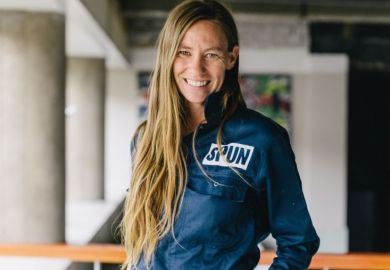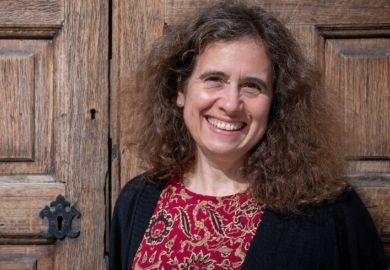Ian Wilmut discovers Rosalind Franklin's love of adventure and fashion.
Major scientific advances rarely arise from the work of one or two isolated researchers. It is much more common for an advance to depend on a group of people and on the foundations that have been laid in earlier work. While Francis Crick and James Watson are well known as being the first to describe the structure of DNA, their discovery was possible only after they had been informed of the results of the exquisite X-ray crystallography of Rosalind Franklin, the subject of this detailed, warm and sympathetic biography. Brenda Maddox quotes extensively from interviews with most of the important participants in her life and has had access to Franklin's personal correspondence in writing a fully sourced biography that will be of great interest to a much wider circle of readers than scientists alone.
Rosalind was one of five children in a well-established London Jewish family. Her father, Ellis, worked in Keyser's bank, where her grandfather was senior partner. His own ambition to study science at Oxford was thwarted by the first world war. Ellis Franklin had very strong views on many subjects and an unusually developed sense of social responsibility. He supported the Working Men's College both financially and by devoting a great deal of his time on a voluntary basis for fund-raising and administration as well as for teaching science. He did not have a second home in the country, believing it to be wrong to do so when many people did not have any home. The entire family assisted Jewish refugees fleeing from the Continent by taking some into the family home.
The Franklins were very well-to-do. A nanny cared for the children and was one of several servants. Rosalind went first to a private day school, where she became, in the words of her father, "alarmingly good at arithmetic". However, at the age of nine she was sent to a boarding school near to the Channel coast. Although she resented being sent away, particularly because a new sister had just been born, her parents were concerned that she seemed a fragile child and thought the sea air would help rebuild her strength.
At the age of 11 Rosalind started to attend a Christian day school for girls in west London. The pupils of St Paul's were encouraged to develop their own interests and opinions. They aimed for high academic achievement; unusually for the 1930s (when Ellis Franklin would not have women work in his office), "every girl was being prepared for a career". Here, Rosalind developed her first interest in science and a few months before her 18th birthday passed the entrance examination for Cambridge University.
Impatient to move on, she ignored advice to take another year before she entered Newnham College. At Cambridge she was in her element, worked hard to earn a first at the end of part one of her natural science tripos, and was able to stay on for part two. But in her final examinations she was awarded only a good second because she was ill when she took them. Neverthless, she gained a college scholarship and the opportunity to begin research. However, this was not a happy experience, with a difficult supervisor who gave her an inappropriate project. The situation was resolved by her being given a wartime post to study coal and charcoal in a government laboratory at Kingston-on-Thames. For this work she was awarded a PhD by Cambridge in 1945.
Maddox gives the social background to her subject's life at this time. She makes it clear that the opportunities for women in academic life were seriously limited and highlights some absurdities. When Franklin was an undergraduate at Cambridge, the first woman professor was appointed, creating a dilemma for the colleges. Custom demanded that a feast be held by each college to mark such an appointment, but also that women should not be invited to feasts. Only King's College London broke with tradition and held a feast with the woman professor as chief guest. The Royal Society elected its first woman fellow only in 1945, having rejected the first proposal in 1902 because as a married woman the candidate was not a legal person and so could not be a fellow! At King's College, where Franklin worked after the war, women were not allowed in the senior common room.
Things were better in France, where Franklin went after receiving her PhD. Her laboratory, on the left bank of the Seine in Paris, was where she learnt X-ray crystallography (as well as how to brew coffee in ceramic beakers, as shown in one of the book's photographs). The head of the laboratory, Jacques Mering, was a deliberate charmer with whom all the young women were in love. He was married, but separated from his wife. Maddox judges that he and Franklin were strongly attracted, but that she was not able or willing to enter into a casual relationship with a man who seems not to have felt it necessary to divorce his wife. Mering later destroyed all her letters to him.
At King's College, where she returned after Paris, there occurred one of the greatest and most wasteful misunderstandings in science. J. T. Randall, head of physics and biophysics, wrote to inform her that "as far as the experimental X-ray effort is concerned there will be at the moment only yourself and Gosling", a student. This was despite the fact that Raymond Gosling and his supervisor, Maurice Wilkins, had already obtained clear photographs of DNA fibres. Wilkins never saw Randall's correspondence and had every reason to think that Franklin was joining his team, while she was encouraged to believe that the research would be her own.
Much of the rest of this story is well known. Franklin's exceptionally accurate X-ray crystallography provided essential information for the unravelling of the DNA code. Watson was excited to realise that DNA must be coiled in a double helix when shown one of her photographs in an indiscrete way by Wilkins. Other details were obtained from what should have been a confidential report. All of this would have been forgivable had Franklin then been informed and given due recognition, but neither of these things happened. Wilkins judged it more appropriate that separate but simultaneous papers describing the X-ray crystallography and the model proposed by Crick and Watson be published. Franklin's unhappy time at King's ended only when she moved to Birkbeck College, where she obtained excellent images of viral structure with Aaron Klug. Sadly, she died prematurely in 1958 from ovarian cancer and so could not have shared the 1962 Nobel prize with Crick and Watson; instead, the prize was shared with Wilkins.
What sort of woman was she? Reality seems to have borne little resemblance to Watson's infamous description of "Rosy" in The Double Helix . Many of the men who knew her mention that she was very attractive and took great care with her appearance. She had dark hair and shining dark eyes often enlivened by a smile. Before she went on holiday in Corsica she made her own bikini soon after this startling new fashion had been introduced. Her letters from Paris discussed the length of French skirts and commented on the tiresome need to lengthen her own to follow the fashion. At school she was an enthusiastic participant in sport. While at Cambridge she cycled extensively and at least once rode back to the family home in London. Hiking was a family recreation Franklin enjoyed throughout her life. Indeed, she is shown climbing in the Alps. She was moved to tears as she watched a beautiful sunrise above a sea of clouds after a 16-hour hike along a high and difficult ridge. She obviously enjoyed travel, whether it was to explore Corsica with a group from the lab in Paris or later in the US.
Although the Franklin children were clearly encouraged and loved, the family was not emotionally demonstrative. Whether through genes or upbringing, Rosalind shared with her father a willingness to debate points fiercely and did not suffer fools gladly. According to the book, she may have kissed her mother on occasion, but never her father or brothers. She learnt the facts of human reproduction when at university by asking a fellow student. Even more important, perhaps, she was slow to learn about relationships between the sexes and so apparently rarely enjoyed affectionate partnership. There is evidence of such a relationship only with Mering and later with Don Caspar, an American with whom she collaborated while at Birkbeck. It was perhaps this innocence that allowed her to swim naked with two male hikers she had just met while on holiday in Wales during her time at Cambridge. According to her female companion on the holiday, it was simply that the day was hot and the lake very inviting. But in contrast to her other relationships, she was openly fond of and very good with children of her family and friends.
Maddox describes an attractive, vivacious, capable, complex woman who made important scientific contributions. Franklin was undoubtedly very intelligent but also a perfectionist. The same attitude extended to everything that she did, including cooking and sewing. Most parts of her life were very happy, but sadly the best-known incident in it was not. Research scientists show the same extraordinary mix of strengths and weaknesses as any other group of human beings. "If you prick, us do we not bleed? If you tickle us, do we not laugh? If you poison us do we not die?"
Shakespeare's famous lines applied to Franklin too.
Ian Wilmut is head of the department of gene expression and development, Roslin Institute, Midlothian.
Rosalind Franklin: The Dark Lady of DNA
Author - Brenda Maddox
ISBN - 0 00 257149 8
Publisher - HarperCollins
Price - £20.00
Pages - 380
Register to continue
Why register?
- Registration is free and only takes a moment
- Once registered, you can read 3 articles a month
- Sign up for our newsletter
Subscribe
Or subscribe for unlimited access to:
- Unlimited access to news, views, insights & reviews
- Digital editions
- Digital access to THE’s university and college rankings analysis
Already registered or a current subscriber? Login



